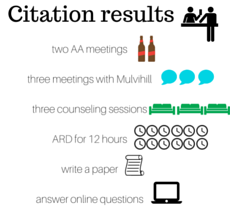Along with failing tests, gaining the “freshman 15,” and searching for internships, getting cited is a common fear among Lehigh students. Most students, however, don’t truly know what the citation process is until it happens to them.
The regularly updated crime log is a reflection of the party culture at Lehigh. Amid all of the arrests on the log, the most common, by a sizable margin, is underage drinking.
“On Monday I get a list of all the students who were arrested over the weekend,” said Chris Mulvihill, the assistant dean of student conduct. “It’s a part of my Monday morning.”
From Lehigh’s point of view, the process is the same, no matter what the citation. Mulvihill explained hypothetically how one could get cited. He painted the picture of a woman who is stumbling in heels as she walks back from a party and gets stopped by the police and breathalyzed. This hypothetical woman blows a .14, so she does not need to go to the hospital, but she is intoxicated.
“No matter if it is the Bethlehem police or the Lehigh police, the officers have some discretion as to whether to cite you for underage drinking,” Mulvihill said.
According to Edward Shupp, the chief of the Lehigh University Police Department, the behavior of the student is what draws the attention of an officer to intervene and potentially issue a citation.
“It could be public urination, staggering and stumbling, vandalism of property, fighting, loud music,” Shupp said.
An officer will not usually take a student in unless he or she is “belligerent.” Instead, they will just hand the student a ticket and the protocol that follows depends on which police force issued the citation. The Bethlehem police informs the Lehigh police of arrests they make. If an arrest is carried out by the Lehigh police, Mulvihill is notified directly.
“I got cited on my first day back to Lehigh this year,” said a female student who preferred to remain anonymous. “We didn’t have a party, but I wanted to go out. We went to (Asian Bistro), then to a fraternity house. I saw my friend I hadn’t seen in a while, got excited, drank too much, and then we left for home.”
The two students thought they were halfway up the Hill, but in actuality they were on Brodhead Avenue. The student’s friend vomited as a cop passed by. She blew a .25 on a breathalyzer, and she and her friend were required to go to the hospital.
“The put me in a room, didn’t give me any water and left all the lights on,” she said, recounting that night. When she got home from the hospital the next morning, she returned to a police officer outside of her house. The officer gave her two citations from the state — one for public drunkenness and the other for underage drinking.
Since the Lehigh police force is one of five university police departments in Pennsylvania that is an accredited department, they have to meet the accreditation standards that are set forward by the Commonwealth of Pennsylvania.
They must have policies in place to respond to any situation — which differs from non-accredited university departments, because when a student gets into trouble at an accredited school, their attorney knows that they are trained to handle the situation properly, Shupp said.
The female student had to pay $220 to apply for Accelerated Rehabilitative Disposition, $150 to attend Accelerated Rehabilitative Disposition, about $1,000 for the ambulance ride and stay at the hospital and $150 for the citation itself.
However, there is much more that comes along with a citation than the fine. The female student had to attend two AA meetings, three meetings with Mulvihill, three counseling sessions with the school, Accelerated Rehabilitative Disposition for 12 hours, write a paper, answer online questions and do 10 hours of community service in two weeks for her sorority.
Moreover, she and her friend were placed on deferred suspension for this semester, probation for next semester, had their licenses suspended in the state of Pennsylvania for six months and cannot participate in any clubs or sports. Protocol such as this is often standard for cited students.
When students get caught with drugs, marijuana being the most common, it is not a citation — it is a misdemeanor that requires the student to be fingerprinted and photographed.
This was unclear to Adrien Remy, ’18, when he got arrested for grinding marijuana in his dorm room.
“I don’t know if I got cited,” Remy said. “I got in trouble, but I didn’t get a yellow slip of paper that says citation. But I think I got cited.”
Remy was handcuffed and escorted out of his dorm and into an Lehigh police cop car and transported to the station for questioning.
“The cop chooses if he wants to press charges or not, which decides if you’re only in trouble with the school or not, and the cop did end up pressing charges,” he said. “So that led to court.”
Like the aforementioned female student, Remy had to attend Lehigh counseling and received Accelerated Rehabilitative Disposition, but the difference is he has to keep up with the magistrate’s office — having to call once a week to check in. These calls include him reporting that he hasn’t changed addresses and is staying on the right track.
Additionally, he has to pay for lawyer fines and is on $10,000 unsecured bail if he doesn’t show up for court or fails a drug test.
“But I don’t have to present that money unless I screw up,” he said.






Comment policy
Comments posted to The Brown and White website are reviewed by a moderator before being approved. Incendiary speech or harassing language, including comments targeted at individuals, may be deemed unacceptable and not published. Spam and other soliciting will also be declined.
The Brown and White also reserves the right to not publish entirely anonymous comments.